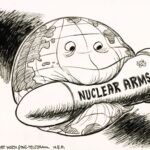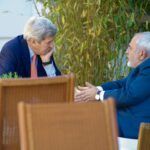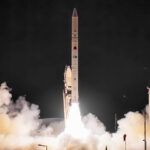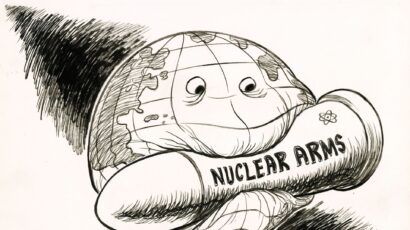Iranian missiles might not be as scary as the West believes
By Farnaz Alimehri | January 21, 2016
On the evening of January 5, Iran’s Tasnim News Agency published photos of another underground ballistic missile facility, one of many throughout the country, according to Brigadier General Amir Ali Hajizadeh, Aerospace Force Commander for the Islamic Revolutionary Guards Corps. The photos and the announcement of President Hassan Rouhani’s plans to speed up Iran’s missile production sparked debate in the United States about the nature of Iran’s ballistic missiles and the future of the Joint Comprehensive Plan of Action (JCPOA), the agreement on Iran’s nuclear program reached in 2015 by Iran, the P5+1 (the five permanent members of the United Nations Security Council—China, France, Russia, the United Kingdom, and the United States—plus Germany), and the European Union. The agreement did not cover Iran’s missiles. Ballistic missiles could deliver a nuclear warhead if Iran’s nuclear program were to move to weaponization stage.
On January 11, an editorial in the New York Times outlined the frightening nature of Iran’s ballistic missile program. It called for the Obama administration to impose new sanctions for Iran’s violation of UN restrictions (while lifting the sanctions covered by the nuclear deal). The administration followed through on January 17, one day after the JCPOA was fully implemented and a plane left Iran with four Iranian-American prisoners, announcing sanctions against 11 individuals and companies involved in technology sales related to Iran’s ballistic missiles.
Though Iran’s ballistic missiles program and recent tests did not violate the JCPOA, they violated UN Security Council Resolution 1929, which forbids “any activity related to ballistic missiles capable of delivering nuclear weapons,” and therein lies the root of the debate. US politicians and some experts in the nuclear community argue that violation of the resolution reflects Iran’s dubious nature and its willingness to continue pursuing an active nuclear weapons program. Iran’s apparent collaboration with North Korea, itself the subject of international controversy lately because of its claim to have tested a hydrogen bomb, has further raised suspicions about Iran’s missiles.
On the other side of the debate, Iranian politicians and some experts who favor the Iran deal argue that Iran never agreed to limit its ballistic missile production under the JCPOA. Moreover, Iran has always held that UN Security Council Resolutions are illegal and therefore not binding on Iran. Now that the JCPOA has been implemented, the resolution specifically banning ballistic missile testing will be lifted and replaced by softer language in the new UN Security Council Resolution 2231. The new resolution, rather than forbidding all activities related to ballistic missiles, "calls upon" Iran not to undertake, for eight years, any activity related to ballistic missiles designed to be capable of delivering a nuclear weapon. The ambiguity of ballistic missiles, specifically the uncertainty of whether or not they could be armed with a nuclear warhead, is understandably frightening to any potential Iranian adversary, yet concerns about Iran’s ballistic missiles are overblown.
Reasons to believe Iran. Before any further policy recommendations can be made to mediate the debate regarding Iran’s ballistic missiles, there remains one issue that needs to be resolved: What are the objectives of Iran’s ballistic missile program? Though absolute certainty on Iranian intentions is impossible to achieve, there are many indicators supporting Iran’s claims that its ballistic missile production is for defensive purposes. First, Iran has complied with, and fully implemented, the JCPOA—meaning that Iran’s nuclear program will be under intense surveillance, leaving no opportunity to secretly pursue the creation of a nuclear weapon. This also means that Iran’s missiles will only be conventionally armed. Second, Iranian Defense Minister Brigadier General Hossein Dehqan has clarified that the specific upgrades planned for Iran’s ballistic missiles will be applied to “improv[e] the ballistic missiles’ precision and [boost] their destructive power proportional to targets.” He stated that Iran did not have any plans to extend the range of the missiles. This could mean that the improvements are not all that significant, and might not be aimed at creating intercontinental ballistic missiles for nuclear weapons delivery. Second, the regional tension between Iran and other powerful countries in the region goes a long way toward explaining why Iran feels the need for greater defense capabilities, and many in the West don’t seem to appreciate the weight this has on Iranian policy.
Many US politicans are skeptical of Iran’s fears of another war, claiming that the example of the Iran-Iraq War—which lasted from 1980 to 1988—is an excuse designed to mask Iran’s aggressive behavior. Yet from practically infancy, Iranians are taught the traumatic effects of this war. Oral histories about the Iran-Iraq War have been passed down to children from grandparents and parents; add rhetoric from the government, and ubiquitous memorials around Tehran and the rest of the country, and it’s not hard to understand why the fear of war is embedded in Iranian culture and consciousness. Iran does not want to be caught unprepared for another war and suffer the way it did in the 1980s. Publicizing Iran’s missile program not only assuages public fears but also has a deterrent effect on the country’s enemies.
The Shiite-Sunni clashes in the region seem to be getting graver every day. In particular, Iran’s reaction to the recent execution of Shiite cleric Nimr Baqir al-Nimr in Saudi Arabia is a clear example of the existing cultural and religious tension, and its potential for rapid growth. The Supreme Leader Ayatollah Sayyed Ali Khamenei referred to Saudi Arabia’s execution as “Daesh-like action” that will not be tolerated. Publicizing Iran’s capabilities and the country’s determination to continue ballistic missile production might be an Iranian attempt to dissuade other regional powers from exercising too much power in the region, particularly when Iranian interests and the existence of the Iranian regime are threatened.
Reasons to disbelieve Iran. Admittedly, it is not unreasonable to doubt Iran. The International Atomic Energy Agency’s final assessment of outstanding issues regarding Iran’s nuclear program, released in December 2015, revealed Iran’s coordinated efforts to pursue a nuclear weapons program until 2003, and other uncoordinated attempts made until 2009. These findings refuted the Iranian regime’s claims of only pursuing a peaceful civilian nuclear energy program, though the IAEA assessment did clarify that Iran was not in pursuit of the knowledge and technology needed to build a nuclear weapon at any point after 2009. The first sanctions imposed on Iran for its nuclear program were in 2006.
Also, while Iran’s missiles could be intended for defensive use, they could easily be used for offensive purposes. It’s difficult to determine what Iran means by statements that it will only use its ballistic missiles for defensive purposes. A perceived threat of regime change, for example, could elicit an offensive response. Moreover, it’s no secret that Iran supports Hezbollah; is an avid supporter of the Assad regime in Syria; and is currently fighting a proxy war with Saudi Arabia in Yemen. Many US politicians and some Arab officials in the region perceive the country’s support of violence in the region as a stepping-stone to a full-scale war against a neighboring Arab country. Expanding Iran’s ballistic missiles program could make an already dangerous situation much worse.
New sanctions, old thinking. Sanctioning Iran over its ballistic weapons program reopened the same, old dialogue that preceded the Iran nuclear deal. It should be clear to all that Iran does have legitimate reasons to defend itself. The Middle Eastern environment is growing more hostile toward the Iranians every day, and the nuclear deal will limit Iran’s ability to create a nuclear weapon for at least the next 15 years. This means that it is unlikely that Iran’s ballistic missiles will be used to deliver nuclear warheads. Furthermore, many countries have ballistic missiles as a legitimate tier of their defense capabilities.
Historical precedent suggests that the regime’s intentions aren’t really that hard to believe, and it is worth considering that Iran may be telling the truth about its ballistic missiles. However, to make its claims more believable to the world, Iran should reconsider its position on supporting violent uprisings in the Middle East. The country should voice its support for joint diplomatic resolutions on regional conflicts, rather that adding more fuel to the fire with harsh, condemning rhetoric. It is hard to believe the Iranians when they are propagating a lot of violence in the region.
The United States has imposed some targeted sanctions on Iran, and it should maintain a strong stance on monitoring Iran’s ballistic missile program, but harsher moves against Iran on a non-nuclear ballistic missiles program—such as those being threatened by Republicans in the US Senate—could jeopardize the success of the JCPOA. Iran is still skeptical of the United States’ commitment to the agreement. Iranian officials viewed the imposition of new US sanctions against Iran just one day after Implementation Day as an example of US duplicity. Let’s not forget that Ayatollah Khamenei threatened to pull out of the deal if the United States imposed more sanctions on Iran. In a January 19 letter, the Ayatollah warned President Rouhani to make sure the US fulfills its side of the JCPOA agreements.
If the United States wishes to maintain and grow a trustworthy relationship with Iran, American trust must be made transparent. The United States must tread lightly as it moves forward, and understand that there might be damaging effects on diplomacy if harsh actions are imposed against Iran.
Together, we make the world safer.
The Bulletin elevates expert voices above the noise. But as an independent nonprofit organization, our operations depend on the support of readers like you. Help us continue to deliver quality journalism that holds leaders accountable. Your support of our work at any level is important. In return, we promise our coverage will be understandable, influential, vigilant, solution-oriented, and fair-minded. Together we can make a difference.
Topics: Nuclear Weapons, Voices of Tomorrow















